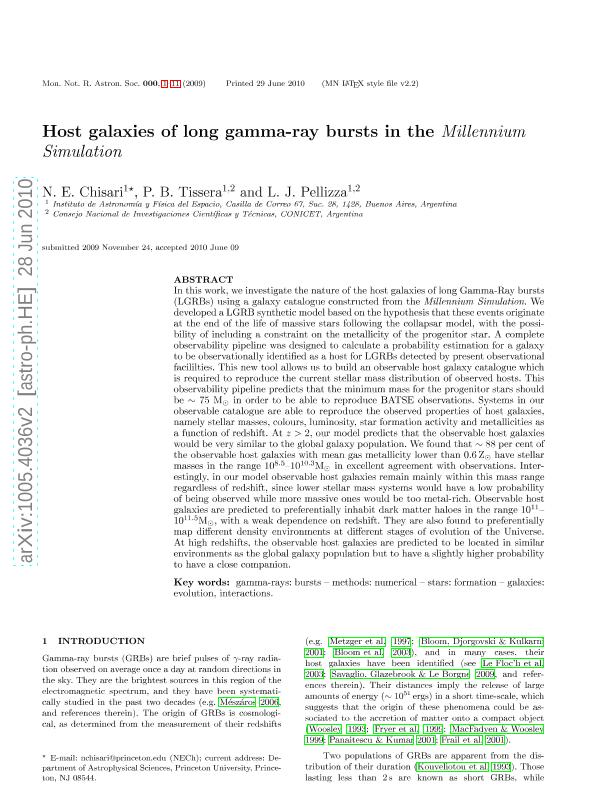Mostrar el registro sencillo del ítem
dc.contributor.author
Chisari, N. E.
dc.contributor.author
Tissera, Patricia Beatriz

dc.contributor.author
Pellizza González, Leonardo Javier

dc.date.available
2017-07-13T21:26:35Z
dc.date.issued
2010-10
dc.identifier.citation
Chisari, N. E.; Tissera, Patricia Beatriz; Pellizza González, Leonardo Javier; Host galaxies of long gamma-ray bursts in the Millennium Simulation; Wiley Blackwell Publishing, Inc; Monthly Notices of the Royal Astronomical Society; 408; 1; 10-2010; 647-656
dc.identifier.issn
0035-8711
dc.identifier.uri
http://hdl.handle.net/11336/20458
dc.description.abstract
In this work, we investigate the nature of the host galaxies of long Gamma-Ray bursts (LGRBs) using a galaxy catalogue constructed from the Millennium Simulation. We developed a LGRB synthetic model based on the hypothesis that these events originate at the end of the life of massive stars following the collapsar model, with the possibility of including a constraint on the metallicity of the progenitor star. A complete<br />observability pipeline was designed to calculate a probability estimation for a galaxy to be observationally identified as a host for LGRBs detected by present observational facililties. This new tool allows us to build an observable host galaxy catalogue which is required to reproduce the current stellar mass distribution of observed hosts. This observability pipeline predicts that the minimum mass for the progenitor stars should<br />be ~ 75 Msun in order to be able to reproduce BATSE observations. Systems in our observable catalogue are able to reproduce the observed properties of host galaxies, namely stellar masses, colours, luminosity, star formation activity and metallicities as a function of redshift. At z > 2, our model predicts that the observable host galaxies would be very similar to the global galaxy population. We found that ~ 88 per cent of<br />the observable host galaxies with mean gas metallicity lower than 0.6 Zsun have stellar masses in the range 10^8.5?10^10.3Msun in excellent agreement with observations. Interestingly, in our model observable host galaxies remain mainly within this mass range regardless of redshift, since lower stellar mass systems would have a low probability of being observed while more massive ones would be too metal-rich. Observable host galaxies are predicted to preferentially inhabit dark matter haloes in the range 10^11?10^11.5M, with a weak dependence on redshift. They are also found to preferentially map different density environments at different stages of evolution of the Universe. At high redshifts, the observable host galaxies are predicted to be located in similar environments as the global galaxy population but to have a slightly higher probability to have a close companion.
dc.format
application/pdf
dc.language.iso
eng
dc.publisher
Wiley Blackwell Publishing, Inc

dc.rights
info:eu-repo/semantics/openAccess
dc.rights.uri
https://creativecommons.org/licenses/by-nc-sa/2.5/ar/
dc.subject
Gamma Rats: Bursts
dc.subject
Methods: Numerical
dc.subject
Stars: Formation
dc.subject
Galaxies: Evolution, Interactions
dc.subject.classification
Astronomía

dc.subject.classification
Ciencias Físicas

dc.subject.classification
CIENCIAS NATURALES Y EXACTAS

dc.title
Host galaxies of long gamma-ray bursts in the Millennium Simulation
dc.type
info:eu-repo/semantics/article
dc.type
info:ar-repo/semantics/artículo
dc.type
info:eu-repo/semantics/publishedVersion
dc.date.updated
2017-07-13T14:03:56Z
dc.journal.volume
408
dc.journal.number
1
dc.journal.pagination
647-656
dc.journal.pais
Reino Unido

dc.journal.ciudad
Londres
dc.description.fil
Fil: Chisari, N. E.. University of Princeton; Estados Unidos
dc.description.fil
Fil: Tissera, Patricia Beatriz. Consejo Nacional de Investigaciónes Científicas y Técnicas. Oficina de Coordinación Administrativa Ciudad Universitaria. Instituto de Astronomía y Física del Espacio. - Universidad de Buenos Aires. Facultad de Ciencias Exactas y Naturales. Instituto de Astronomía y Física del Espacio; Argentina
dc.description.fil
Fil: Pellizza González, Leonardo Javier. Consejo Nacional de Investigaciónes Científicas y Técnicas. Oficina de Coordinación Administrativa Ciudad Universitaria. Instituto de Astronomía y Física del Espacio. - Universidad de Buenos Aires. Facultad de Ciencias Exactas y Naturales. Instituto de Astronomía y Física del Espacio; Argentina
dc.journal.title
Monthly Notices of the Royal Astronomical Society

dc.relation.alternativeid
info:eu-repo/semantics/altIdentifier/doi/http://dx.doi.org/10.1111/j.1365-2966.2010.17169.x
dc.relation.alternativeid
info:eu-repo/semantics/altIdentifier/url/https://academic.oup.com/mnras/article-lookup/doi/10.1111/j.1365-2966.2010.17169.x
dc.relation.alternativeid
info:eu-repo/semantics/altIdentifier/url/https://arxiv.org/abs/1005.4036
Archivos asociados
